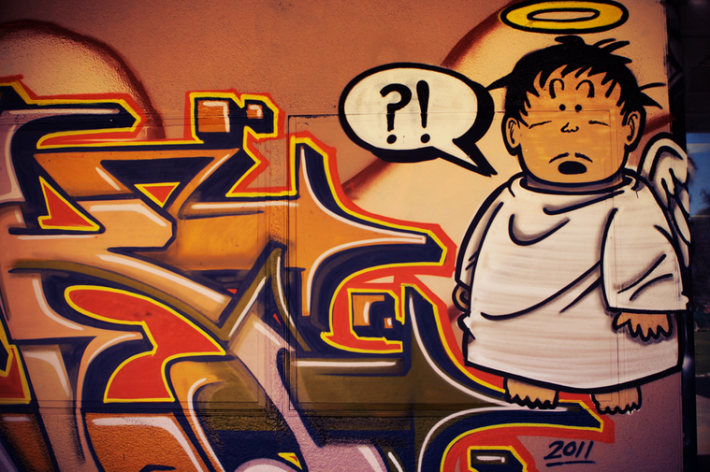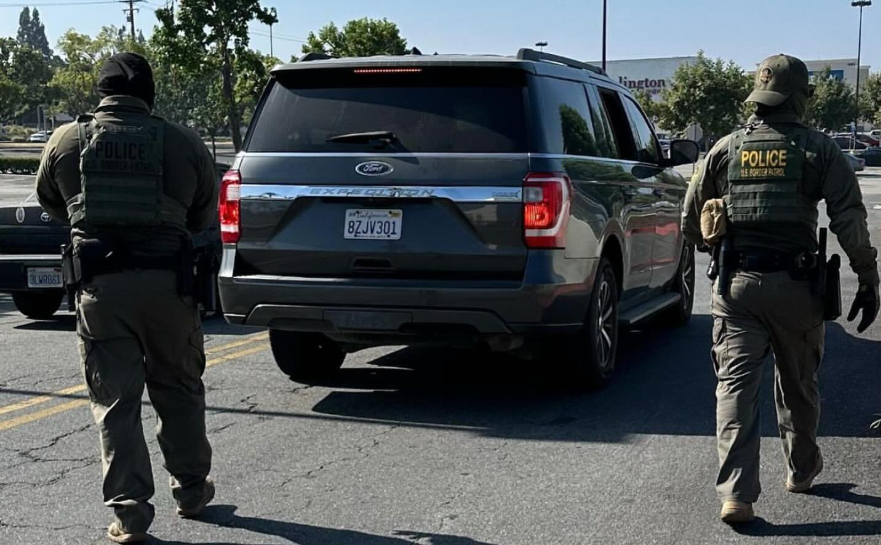
We should create open, free, accessible graffiti space.
There, I said it. And I know it holds with it a plethora of cons--the term graffiti itself, the worry of what will be painted, the influx of those people that neighborhoods supposedly "don't want"--and I, albeit begrudgingly, get this.
I know my choice of terminology--"graffiti" over "street art"--is, in and of itself, problematic for many. Street art has become this strangely accepted form of art--think Basquiat's jump from graffiti art to museums, MOCA's Art in the Streets or Paris's Fondation Center's Born in the Streets or the Bay Area's Special Delivery--that has some sort of museum and social authority attached to it thanks to the (well-deserved) works of Banksy, Shepard Fairey, Space Invader, Barry McGee, Long Beach's own Skullphone and Help Desk, and others. And though many can argue against it, my definition of graffiti in regard to being placed against street art is that graffiti is of-the-moment and limited to what can be done on the spot; it lacks a message being brought to the space more than a space igniting the message.
And with this, I ask you to at least hear me out: Long Beach is the perfect canvas.
I received an e-mail from one of my undergrad alumni informing me that one of my favorite neuroscientists, Jonah Lehrer, had given the keynote speech at the Theatre Communications Group (TCG) annual conference a couple years back. Given that my writing specialty is in dramatic writing, I was thrilled and, to be honest, somewhat confused that a neurologist was giving the keynote at a theatre conference.
While the TCG wasn’t legally allowed to provide a transcript or film the keynote, so many people had tweeted direct quotes that for those who were unable to attend--like my poor post-graduate self--were able to get the general gist of his fascinating speech, entitled "This is Your Brain on Theatre."
The basic thrust of Mr. Lehrer's speech was that theatre and the arts as a whole remain essential--even in the age of the iPhone. Pointing out that children who can delay their gratification also garner higher test scores was attributed, at least for Lehrer, to the ability of the child to focus their attention and intention more precisely--something that is utterly important since, with the bombardment of information coming at us, it is far more important to be able to parse information that it is to remember it all.
Art, in this particular sense, builds the muscle of focus--especially odd, complex, or difficult art. Take theatre, for example: the layers of plot, theme, language force the viewer to use various parts of cognitive ability to process the information at hand. In a single swift moment, we are moved through multiple levels of comprehension. When applied to all forms of art, this means we move between local comprehension--who is this artist? what did he/she/they use to make this piece?--and global understanding--what is the piece trying to convey? what are the underlying values of such a piece?--that ultimately helps us empathize, to understand the endeavors and struggles of others.
To those who question the function of compassion, I defiantly encourage you to look at empathy's scope outside of charity. Empathy--through someone else's story, however that story is conveyed--is not only what art is, but is a general driver in the solving of problems. And that is because sometimes the hardest part of creativity is not finding the solution, but the problem--which in turn, creates innovation.
Lehrer made an interesting observation: Why does the city of San Francisco have the most patents generated than any other city in the United States? According to his logic, San Francisco found a way to mitigate its isolation. Cities that invite direct mingling of diverse persons in parks or on sidewalks create what he called intimate inefficiencies--and these random encounters yield more innovations.
In other words, mutual incomprehension leads to innovative solutions.
The unplanned nature of the urban ballet is like an email to a stranger: we need the spontaneous sidewalk encounters. The act of explaining what you think to someone from a different background causes creativity. A diverse team is more successful because we are forced to explain ourselves, and by doing so, reach a deeper understanding.
Long Beach has access to the keypoints Dr. Lehrer describes in an innovative metropolis like San Francisco: we are a diverse team, with active ethnic and cultural communities. Yet, Long Beach is always tagged as "up-and-coming" without upping or coming, particularly when it comes to the arts. Those pushing for arts are often ignored or outcast. It is like we have this massive amount of potential to create these random encounters and interactions and yet we store up the potential in seal-locked warehouses.
So I ask a very difficult, albeit essential question: how can we increase these "intimate inefficiencies" while maintaining the aura that makes Long Beach so distinctly Long Beach?
It is here where I propose open graffiti spaces.
Graffiti art has long been a contest between politicians and those who partake in the actual act of graffiti. However, it has also long surpassed its moniker of being associated with gangs and violent, territorial proclamations.
The aforementioned artists have helped catapult graffiti into a legitimate form of artistic expression, respected amongst established museums, curators, and art gallery owners. It is not just about tagging your respected area code or proclaiming ownership; it is about critical reflections, political turmoil, social injustice. One but has to visit the 5 Pointz warehouse in Queens, New York or along Pont Saint-Louis in Paris to see this.
Of course, the most fascinating part about graffiti art is that, artistically speaking, it finally bridges a very large gap between classes. Art in museums has long been viewed as pretentious and inaccessible to people of lower incomes or those without access to education. Graffiti art, for them, has been a way to express themselves without having to mitigate their expression due to social norms.
And cities are beginning to shift their perception of graffiti and providing local artists free, legal spaces in which they can openly create. The 5 Pointz warehouse in Queens, New York is an incredible reflection of the artistic possibilities of providing such a space. When I visited Copenhagen, I was enthralled by Sydhaven, an open, legal space that continually changes and shifts as graffiti artists create beautiful and oftentimes massively complex pieces. The Venice Graffiti Pit in Venice Beach has long been admired for its ever-shifting façade. Burghausen, Germany has a 150-meter long wall dedicated to open graffiti. The abandoned Rote Fabrik silk mill in Zurich is now an officially sanctioned space for graffiti art. In Prague, the Tesnov tagging area was even chosen because of the excellent lighting it provided artists.
These examples provide concrete evidence that graffiti can no longer be singularly considered vandalism. And I offer a very daunting but innovative proposal: why don’t we not only create open graffiti spaces in Long Beach, but actually become the cultivator of street art? No city has taken on this task (shocking to me considering that graffiti art is clearly the fastest growing form of artistic expression).
I propose this for two reasons: it will provide youths, typically unable to access traditional art spaces or materials, with a place where they can express themselves and, more importantly, be seen. They have visibility, perhaps even a chance to create a career out of their art. Secondly, and just as importantly, I go back to Dr. Lehrer’s emphasis on a city creating random encounters. If Long Beach creates these free tagging spaces, can one imagine the endless random encounters it will generate? When will a citizen of Belmont Shore ever have the chance to approach a tagger from North Long Beach and ask him or her or them why they’re creating what they are creating? How will that conversation shift perceptions? And, as I previously mentioned, how much empathy will such a transaction foster?
Not only as an artist but more importantly as a Long Beacher, I understand the insane and almost impossible amount of complications and problems that such a proposition holds. But just as equally, I believe taking this step will not only act as a catalyst for creativity and innovation within Long Beach, it will truly mark Long Beach as an innovative city willing to stand out atypically from its fellow urban spaces.






